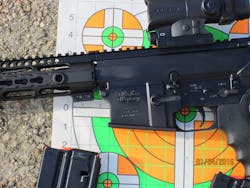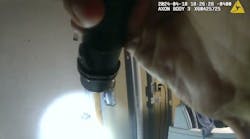Windham Weaponry’s .308 Semi-Auto
If you’re in the market for a semi-automatic .308 rifle, let me suggest you take a look at the Windham Weaponry R18FSM-308. Built on the AR platform and incorporating some contemporary design features, the rifle performed well in recent testing and is advertised at a more-than-reasonable price tag. With the versatility offered from the caliber, this rifle, equipped with a proper sight, should let you accurately engage targets from inside-the-room distances to well past 300 yards. Most law enforcement won’t ever need that kind of distance. Let’s take a closer look.
The debate over whether a patrol rifle should be chambered for .223 or .308 is nearly as old as the argument with many law enforcement administrators as to whether or not patrol officers need them at all. Since the advent of active shooter response protocols and the follow on training, the debate about need has abated. Once the need was agreed on, the next argument was handgun caliber versus rifle caliber. Once the debate was won in favor of rifle caliber the question became .223 versus .308 (and now .300 Blackout is in the mix). The low stress answer is: pick one. Windham makes quality semi-auto rifles in all three calibers. I recently received one of their .308 caliber ARs for test and evaluation. Here’s what I experienced.
Basic information first. The WW-308 I received is an AR-style rifle chambered for .308. It came equipped with no sites or optic (at my request), just flat top picatinny rails full length to include handguards and top of receiver. For testing purposes I mounted an HD7 Gen III optic from Lucid. Because I live in the wonderful state of Maryland, I received one 10-round magazine with the weapon. That makes testing a bit tedious (and you get tired thumbs) so I acquired two 20-round magazines from D&H Industries. (More on Lucid and D&H farther down).
My test rifle is the Windham Weaponry Model WW-308 as stamped on the receiver. It is the (online) R18FSM-308. It has an 18-inch fluted chrome lined barrel with an A2 flash suppressor. Mine has a MagPul MOE fixed stock (photos online show that OR a six-position telescoping stock). The storage space inside the Magpul stock is quite handy.
The rest of the rifle is as you would expect from a company of this caliber manufacturing a rifle of this type:
Action: Semi-Automatic, Gas Impingement System
Receiver Material: Forged 7075 T6 Aircraft Aluminum w/ Integral Trigger Guard
Receiver Finish: Hardcoat Black Anodized
Barrel: Chrome lined 4150 Chrome Moly Vanadium 1159SE steel
Rifling: 1 in 10 inches – Right Hand Twist – 6 Lands & Grooves
Forend: Midwest Industries Key Mod Free Float Handguard w/ rail segment
Pistol Grip: Hogue Beavertail Overmolded Grip
Front/Rear sight: None
Weight: 8 pounds (without magazine)
Overall Length: 38 inches
All accuracy testing was done using Federal’s Gold Metal Match 168g .308 ammo. Function testing was done with the assortment of various manufacture and bullet weight ammo I had in my .308 can at the time.
I made my way to the range with the rifle as described, the two 20-rd D&H Industries magazines and several boxes of the ammo. The range I was using is limited to 100 yards but that was actually perfect for my purposes. Having field stripped the weapon and given it a basic cleaning, I lubed it and loaded it and set up, at first, at the 25 yard line. I had mounted the Lucid optic and needed to get it aligned sufficiently to at least be able to hit the target at 100 yards. I wasn’t going for a perfect zero; just close enough for testing purposes.
Then I moved back to the 100 yard line, loaded two full magazines and got comfortable at the bench. Firing from a bench rest and using the dot/circle reticle option on the optic (again, more about that further down), I fired my first twelve rounds in four 3-round groups. Unloading and clearing the weapon I went down range to check my work and found three groups that all measured less than one inch, while the fourth group had an uncalled flyer that stretched it out to 1.75 inches. Was that me? The ammo? The weapon? I needed to find out.
I put up a fresh target and headed back to the shooting bench. I added one round to the 8-round magazine I had left and sat back down. My next three 3-round groups all stayed within the 1-inche I was hoping for. The smallest group was actually just one-hole that measured about .6 inches. The largest was right at one inch. Recoil on the weapon is noticeable but not uncomfortable. In my mind it was the same as shooting a .308 bolt gun, although several other shooters reported feeling more recoil with the AR rifle (different range day). I can’t account for that. My mind knows that the semi-automatic system absorbs part of the recoil with every shot. Still, at least three shooters felt the bolt gun “felt” like it had less recoil (bolt gun was a HOWA).
With the Federal Gold Match ammo the weapon (with me at the controls) consistently shot sub-MOA groups. The smallest I measured was .4 inches; the largest was the 1.75 inches mentioned above, but it was the only group I fired over 1 inch. I have to believe that was something I did. After I was satisfied with the accuracy, I decided to test the functionality. I had cleaned and lubed it (Militec-1 is my lube of choice) and I proceeded to load the magazines with the mish-mash of .308 ammo I had in my can. There were at least four different manufacturers of ammo represented and some of that ammo was years old (I’m guessing five or more). I experienced no malfunctions of any kind while going through five magazines’ worth (100 rounds) of that mixed ammo.
Overall I give the Windham Weaponry WW-308 two thumbs up. I feel like I could get even more accuracy out of it if I mounted a true precision optic, but I also feel like a semi-auto .308, in the LE world at least, isn’t going to be used past 200 yards anyway and at that range or less, a sub-MOA gun is more than sufficient. MSRP on the Windham Weaponry website is $1732.75 but I imagine you can find them for a lower price if you search around. Even at full MSRP you get your money’s worth.
Now, as promised: The Lucid HD7 Gen III red dot sight is a non-magnified rail mounted electro-optic. The frame is cast aluminum and it’s advertised as 100 percent waterproof and fogproof (didn’t test it for either). It is also reportedly 100 percent shockproof as tested on a .458 SOCOM weapon. It requires 1 AAA battery to function. It is fully rubber armored and weighs 13 ounces. There is an auto-brightness mode and there are four reticle options. The reticle is adjustable for windage and elevation in ½ MOA clicks. A 2X magnifier is available for it. An online search shows them available for less than $180 (not including S&H).
Finally, the last component: The D&H Industries magazines. I’ve used D&H mags for everything from my 1911 to my AR-15 to this WW FSM-308 and I’ve never experienced a magazine induced malfunction. They are all metal and fit/function well. (Nothing is perfect, but I’ve not found a flaw in these yet).



